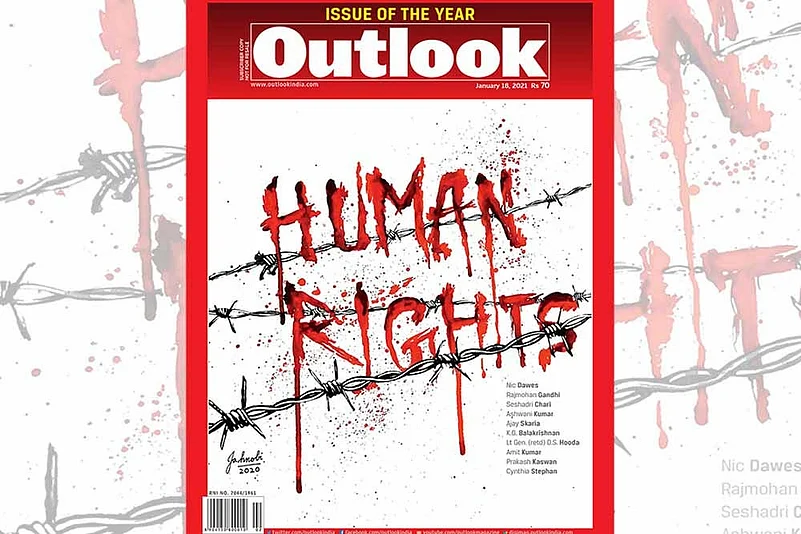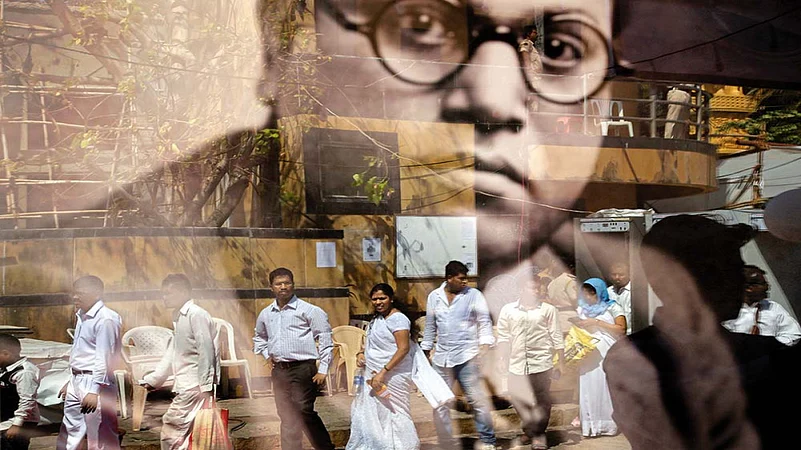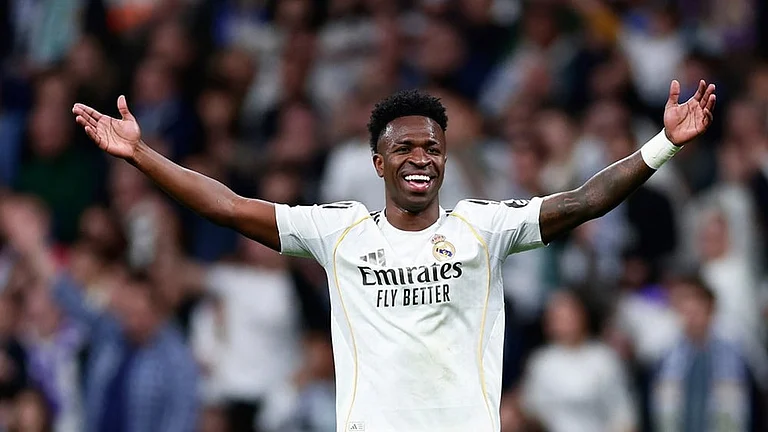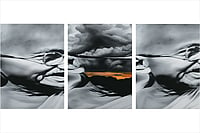As the influence of Vinayak Damodar Savarkar in Indian public life has risen, so has the insistence on his honorific, Veer—heroic, brave, courageous or warrior-like. When a plaque was put up in the Andaman Cellular jail, it was to Veer Savarkar. When roads are renamed, they are usually to Veer Savarkar, rarely to V.D. Savarkar. Nor is it only Savarkar’s admirers who are taken by the honorific—now newspapers and other media sources use it too. Savarkar has become inseparable from his honorific.
We do not know much about how the honorific originates. Its earliest confirmed use, Niranjan Takle notes, was by a journalist in the 1920s. That Savarkar himself may have played a role in coining and popularising the honorific cannot be ruled out. Soon after his release from prison, the book Life of Barrister Savarkar was published. Its author is identified simply as Chitragupta; only many years later did people learn that Savarkar himself was its author. That book, available online, glows with rapturous admiration for Savarkar, for his valour and bravery. What emerges very clearly from it is not merely Savarkar’s skill at self-promotion, but also that it was very important for him to think of himself as brave, and project himself to the world as brave. (In his recent hagiography, Vikram Sampath sidesteps the discomforting issues raised by Savarkar’s sly adulation of himself with the sentence that “the identity of the author remains a mystery”.)
ALSO READ: In Our Roots Are Our Rights
The honorific is all the more intriguing because it does not fit Savarkar very well. In the case, say, of Bhagat Singh, all that we know about him suggests the honorific is appropriate. But matters are murkier in Savarkar’s case. To begin with, something is a bit off about how Life of Barrister Savarkar itself harps on Savarkar’s valour. The brave do not normally go around shouting to the world about their bravery. For example, Gandhi, despite celebrating courage so much, does not think of himself as courageous enough.
Matters get murkier still when we consider Savarkar’s actions. His actions before his arrest certainly display remarkable fearlessness. But during his incarceration in the Andaman jail, he wrote three obsequious petitions to the British, promising complete cooperation if released. Trailokya Nath Chakraborty, in his memoirs Thirty Years in Prison, notes the Savarkar brothers were “favourites of the jailor”, and when the other prisoners engaged in a protest, “the Savarkar brothers used to encourage us secretly, but when asked to join us openly, they refrained.” I do not wish to denigrate Savarkar for making these petitions: the vicious tortures the British specialised in inflicting on Andamans prisoners are legendary. Also, maybe the petitions were strategic, as his admirers want to believe. Still, the petitions, the furtiveness of his support for the prisoners’ protest and the way he curried favour with the jailor do make the ascription of courage to him contentious—only three political prisoners, including his brother, apparently ever wrote mercy petitions.

ALSO READ: Our Wronged Rights
Then, after his release from Ratnagiri prison, while he encouraged his followers—for example, Godse—to acts of violence, he made sure he would not be implicated. Again, his admirers suggest he was only acting as a good general by sacrificing others and conserving himself for the larger cause. Maybe so. But an even more troubling example could be from Six Glorious Epochs of Indian History, where he says Muslim invaders raped Hindu women, and castigates Hindu rulers, including Shivaji, for not having resorted to retaliatory rape. It is difficult by any criteria to describe as heroic or courageous somebody who calls for the use of rape as a political weapon.
When an honorific fits so very poorly, the question arises: why was Savarkar so drawn to it, and why are people so drawn to it today? Why not describe Savarkar with terms that fit him better—say, as a savvy or strategic actor, as a modern-day Chanakya, after the present fashion? Why does the honorific matter so much to his followers and him, and why have we as a society concurred in perpetuating it? What work does the honorific do? Why are his greatest admirers so keen to claim a similar courage for themselves—witness, for example, Narendra Modi’s claim that he has a 56” chest?
ALSO READ: Nailed To The Cross, Ripe For Rescue
Such questions are perhaps best framed in terms of a larger question: what is the relation between democratic politics and fearlessness? Fearlessness is not only a matter of individual disposition; it is a fundamentally social and political phenomenon. Institutional mechanisms and interventions can inhibit or cultivate fearlessness, as can social or political practices. Democratic life needs fearlessness. Sometimes dramatically so, as when people vote despite intimidation. At other times, it is so in more everyday ways, as when marginalised groups expect and demand to be treated with dignity, or when courts deliver judgments without fear or favour. It is also structurally so, for at the heart of democratic politics is the practice of treating others as equals. Minimally, these equals are limited to fellow citizens, but more radical forms of democratic politics would include treating non-citizens and maybe even all life as equal. To treat others as equal is to render oneself vulnerable to them, which is impossible without considerable courage. Also, some kinds of fearlessness threaten democratic life. For example, Hindu vigilantes who attack Muslims during riots, even if emboldened by official patronage, do on occasion practise a certain fearlessness.
In this context, democratic polities temper the demand for courage by institutionalising rights—most of all, equal liberty for all citizens, a protean right concretised through various more specific rights such as freedom of speech, association, assembly and movement. Still, formal rights cannot do away with the need for the spectacular and everyday courage required to exercise those rights. This need grows when rights are threatened, or when their meanings have to be extended. So to attend to courage is to attend to that which infuses the very spirit of democracy, and underlies institutionalised democratic rights.
ALSO READ: Floydian Slip
Drawing on Gandhi helps us distinguish between four forms of fearlessness relevant to democratic politics: rage, and three kinds of courage—the warrior’s courage, moral courage and religious courage. Though courage and rage are partial homonyms, their etymologies are very different, as indeed are their meanings. The word courage emerges from the Latin cor or heart, whereas rage emerges from the Latin rabies, and carries the sense of a madness or an insanity. Those seized by rage seem to become fearless, but this fearlessness is not to be confused with courage, or with the anger the courageous often experience. Where cowardice is the absence of courage and recklessness the excess of courage, rage is the active and paradoxical negation of courage, arising from the weaponisation of cowardice. A meaningfully democratic citizenship requires not only questioning rage, but also a courage that is minimally moral and maximally religious, and might find its incipient protocols in the warrior’s courage.
***
In Gandhi’s writing we can discern the distinction between courage and rage. After the assassination of Curzon Wylie by Madan Lal Dhingra, who was associated with the pre-Hindutva Savarkar, Gandhi writes: “I do consider Dhingra to be a patriot, but his love was blind. He gave his own body in the wrong way.” “If I kill someone in my own house without a warning…[I] cannot but be called a coward. There is an ancient custom among the Arabs that they would not kill anyone in their own house, even if the person be their enemy. They would kill him after he had left the house and after he had been given time to arm himself. Those who believe that violence will lead to good would be brave men if they observe these rules when killing anyone. Otherwise, they must be looked upon as cowards.” Also, “men can do these things in a state of intoxication…[which] can also banish the fear of death. Whatever courage there is in this is the result of intoxication, not a quality of the man himself. A man’s own courage consists in suffering deeply and over a long period. That alone is a brave act, which is preceded by careful reflection.” Whether he is right about Dhingra or not (to my mind, he is projecting onto Dhingra the disposition he might have discerned in Savarkar, whom he had met in London), this weaponisation of cowardice we would surely today recognise in Hindutva.
ALSO READ: Mind The Gap

As these remarks also suggest, Gandhi does not work with the conventional understanding of warriors as those who give their life to a higher cause. For him, what distinguishes ranveer or warriors is that they fight only equals or superiors, even refuse to fight those less accomplished. So warriors practise a discipline (and such discipline involves “careful reflection”, even if it is realised in split-second action) that makes them vulnerable, put their own life at risk, live with death as a companion—otherwise, it is not an equal battle.
ALSO READ: Silent Alarm
In other words, for Gandhi the courage of warriors both introduces the question of equality, and stresses the form necessary to this equality—that of risking one’s life, making oneself vulnerable. Nor is Gandhi alone is stressing this performative equality: the libraries of courage and fearlessness repeatedly stress the need to find a worthy foe. Warriors may be reckless in their courage, taking on those who are more than their equal, but this is the excess internal to courage, it is the striving to always find an equal foe. Only such a foe can be respected, made into a friend.
Two things to note about this way of thinking about courage. First, it breaks apart the usual concept of physical or bodily fearlessness. While he does talk of physical or bodily force, and recognises that both warriors and those made fearless by intoxication or rabidity embody this force, for him they do so in incomparably different ways. True, the latter fantasise that they too are warriors, and the attribution of the prefix ‘veer’ to Savarkar is arguably one symptom of this rabies. But the fearlessness of rage can never permit equality to its opponent; this fundamental difference forever separates the intoxicated or the rabid from the courageous.
ALSO READ: From The Ballad Of Indian Gaols
The contrast between these forms of fearlessness is by no means original to Gandhi. Perhaps it makes its way into his writing from the Mahabharata, which he read so obsessively. On the one hand, there is in it the enraged fearlessness of Ashwatthama, who goes on the rampage that wipes out the next generation of the Pandavas. On the other hand, there is in it Bhishma, he of the terrible vow, who seeks first to battle Krishna, for a death in such a battle would be valorous, and then refuses to battle Shikhandi rather than win an inglorious victory. (By our contemporary understanding, unthinkable in the time the epic was composed, Bhishma’s reasons for not fighting are themselves inglorious—Shikhandi was a woman, Amba, in his previous life.) By the terms Gandhi learnt from the Mahabharata, Savarkar and the followers of Hindutva are the Ashwatthamas of the modern world—consumed by a rabies that condemns them to only destroy, the antithesis of what is most worth admiring and nurturing in Hindu traditions.
Second, this way of thinking about courage intimates a distinctive morality. Like most philosophical and religious thinkers, Gandhi does not subscribe to the anodyne understanding of morality as the code of conduct broadly accepted by a society or group. For him, morality and religion involve fidelity to the question of being or truth, both of which are condensed in the term satya. And since courage—an elusive thing, surely, since we can never be sure we have it—is required to be consistently faithful to such a question, there is no morality without the striving for courage.
ALSO READ: Tiger, Tiger Whining Bright!
What arguably makes his uptake of satya distinctive is the emphasis on the equality of all being. Such an equality must necessarily be conceptualised very differently from our usual concept of equality. That latter is an equality of similarity or resemblance—an equality in terms of certain shared criteria. It presumes what Amartya Sen calls an “equality of what”. As that phrase suggests, equality is here along one plane, and not on all: we may strive for the equal right of everybody to be a free economic agent, but this would mean also accepting the economic inequalities that will follow. Conversely, we may strive for an actual economic equality, but this would mean imposing restrictions that will be unequally experienced by people in different circumstances. In other words, we accept some inequalities in order to achieve the equality we prize most. The equality of similarity or resemblance is always an equality of what, an equality along those planes considered most valuable.
An equality of what, need it be said, is very difficult between entities as different as humans, non-human animals and things. Even within humans, this equality is difficult—as Hannah Arendt wrote in the wake of the Holocaust, “The conception of human rights based upon the assumed existence of a human being as such broke down at the very moment when those who professed to believe in it were for the first time confronted with people who had indeed lost all other qualities and specific relationships except that they were still human. The world found nothing sacred in the abstract nakedness of being human.”
ALSO READ: Pray, Speak The Truth, Milords!
All this is not to dismiss an equality of similarity—no politics committed to social justice can ever afford to. But because he was so acutely aware of its violence, Gandhi is sceptical of it, and is drawn instead to the equality of difference or singularity, or what could also be called, as a counterpoint to Sen, an ‘equality of who’. This equality is not along any one plane of similarity; it courses through all of one’s being. And it can only be performed by being vulnerable to the others with whom one seeks equality.
For this performative equality, which is the spirit that animates the institutionalised order of rights, Gandhi finds an incipient protocol in warriors’ practice of seeking out enemies they are vulnerable and equal to. Still, the very purpose of battle is to overcome enemies; also, warriors may decree a permanent inequality with non-warriors. As such, they certainly do not represent some sort of pure or unsullied origin for equality; they are at best quasi-moral figures. From them Gandhi receives that fleeting opening where equality and vulnerability come together. This opening, in his writing the crux of morality, he radicalises.
***
In 1910, Gandhi writes to his nephew, Narandas Gandhi: “Do you know the fundamental principles of our religion? … Knowing the fundamentals, as I interpret it, means putting them into practice. The first attribute of the divine heritage is ‘fearlessness’ [abhay]. I hope you remember that verse. Have you attained to the state of ‘fearlessness’ to any extent?” As those words suggest, for Gandhi this is a religious fearlessness. He espies this fearlessness in both Hindu texts—the verse referred to is in the Bhagavad Gita—and classical Jain traditions (though he finds it absent in the Jainism of his times). Drawing on them, he describes satyagraha as an enactment of abhaydan, the gift of fearlessness referred to in Jain texts.
ALSO READ: Evidence Of Absence
In Unconditional Equality, I explored the transformation of the warrior’s courage into the religious courage of abhaydan. Satyagrahis are for Gandhi the true warriors because they practice an even more intense and fearless equality than armed warriors. Where the latter seek to kill or otherwise subdue their opponents, satyagrahis lay down their arms and make themselves vulnerable to their opponent. This surrender without subordination makes their equality very different from the warrior’s equality. With the satyagrahi, equality and courage both become intensely religious—sustained only by faith, not by the reasonable and calculated hope of a reciprocal response from the opponent, as in more conventional struggles. Gandhi and Ambedkar, those two figures who as political actors were in an antagonistic relation, but as thinkers were and are in a parallax relation, both enact this religious courage—Gandhi through abhaydan and satyagraha, and Ambedkar through maitri.
Here, I would like to complement the book’s argument by exploring another transformation of the figure of the warrior—that involved in the moral courage required for republican democracy. I use the term republican democracy as a counterpoint to majoritarian democracy. The latter, adapting slightly a formulation by Simona Sawhney in an unpublished essay, ‘Godse’s Gandhi’, makes democracy “not an end, but a means. The end is the assertion of power [by the majority]. Just that: the assertion of power, display of power, the exercise of power.” By contrast, republican democracy is the institutional form affirmed by the leading framers of the Constitution, including Ambedkar, Nehru and Patel, despite the enormous political differences between them. Republican democracies modulate and limit the rule of the majority by codifying and guaranteeing rights for those in a minor or marginalised position.
ALSO READ: In Search Of Sadda Haq
Most evidently, individuals exemplify this position: after all, an individual alone, without rights or some other form of strength, is powerless against the might of society or state. Mainstream forms of republican democracy thus institutionalise the individual right to equality and liberty. Radical forms of republican democracy, such as the one Ambedkar advocated in States and Minorities, go much further. They recognise that relatively powerless groups such as Dalits, Muslims, or women are also minoritised through oppression—discriminated against because of some traits they are presumed to share. They recognise also that large swathes of society may be minoritised through exploitation—farmers and labourers, for example, and the large urban precariat. They thus additionally call for social and economic rights to equality and liberty. In both its mainstream and radical forms, republican democracy seeks an institutional and social order that nurtures spaces for the minoritised, usually by providing for rights; democracy in this sense itself becomes the end, not power for the majority.
The Constitution was a compromise between the mainstream and radical visions of republican democracy. But it was undermined almost from the start by the working of capital and majoritarian social forces. And while it persisted for a long time in a battered factuality, it arguably now lies close to ruin.
(These excerpts are adapted from a longer essay, available on the Outlook website, that goes on to examine the figures of Nehru and Ambedkar and differing concepts of equality.)
ALSO READ:
Ajay Skaria is Professor of History and Global Studies at the University of Minnesota






















